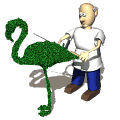Houseplant Care

When Should I
feed?
As a general rule
your houseplant should be fed when growing and flowering but not during the resting
period, the latter often being in the winter. When you arrive home with your new green
houseplant it is not usually necessary to feed it right away. The compost, in which the
plant is potted, will have enough nutrients for at least a month. By the end of this time
the soil will contain less food as it will have been taken up by the roots and drained
away with watering. Then is the time to feed. Buy a good certified food, a liquid food is
the easiest to administer, that is, one that is added to the watering can. Follow the
manufacturers instructions carefully avoiding putting extra drops in "for the
pot"! Over feeding will probably cause more long-term damage than under-feeding. You
can also buy feeding sticks and pills that are pushed into the soil. These might appear an
easy option but can concentrate the food in one small area and can continue to release
food during the resting period.
The main ingredients
of plant food are nitrogen which promotes leaf growth, phosphates to develop the roots and
potash to produce flowers. These are carefully balanced with other trace elements to form
a established compound fertilizer. There are different types available on the market to
suit green and flowering houseplants.
How Often Should I
Water?
This is the one
question everyone asks when they purchase a new plant, but is also the most difficult to
answer. Think of it as a favorite member of your family - give them plenty to drink in
summer when it's warm, but offer only small glasses when it's cold. Get to know your plant
and you will soon see how it likes to be treated. Signs of stress will show as limp or
discoloured leaves and an unhealthy looking specimen. The best method to see if you plant
needs watering is to poke your finger down into the soil. Sometimes the surface will
appear to be dry but underneath the soil could be soggy. Don't forget most houseplants are
killed with kindness! If you have forgotten to water it don't suddenly flood the poor
thing with water as this could finish it off altogether.
For most plants
little and often is the best remedy. One way to ensure that you don't over-water is to
fill the plant saucer with water and after 30 minutes throw away any excess that the plant
hasn't absorbed. There are a few exceptions to this however, e.g. the Azalea. Azaleas need
to have their whole pot immersed in water once a week to ensure the water gets into the
root ball.
So get to know your
plant - don't be in a rush to water; with most species a slight wilting of the leaves will
let you know it's thirsty - but be careful as this can also be a sign of over-watering.
And don't forget
even a cactus needs watering in the summer.


|